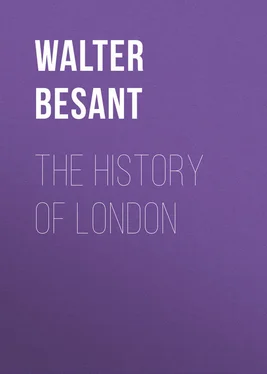Walter Besant - The History of London
Здесь есть возможность читать онлайн «Walter Besant - The History of London» — ознакомительный отрывок электронной книги совершенно бесплатно, а после прочтения отрывка купить полную версию. В некоторых случаях можно слушать аудио, скачать через торрент в формате fb2 и присутствует краткое содержание. Жанр: foreign_antique, foreign_prose, Историческая проза, на английском языке. Описание произведения, (предисловие) а так же отзывы посетителей доступны на портале библиотеки ЛибКат.
- Название:The History of London
- Автор:
- Жанр:
- Год:неизвестен
- ISBN:нет данных
- Рейтинг книги:5 / 5. Голосов: 1
-
Избранное:Добавить в избранное
- Отзывы:
-
Ваша оценка:
- 100
- 1
- 2
- 3
- 4
- 5
The History of London: краткое содержание, описание и аннотация
Предлагаем к чтению аннотацию, описание, краткое содержание или предисловие (зависит от того, что написал сам автор книги «The History of London»). Если вы не нашли необходимую информацию о книге — напишите в комментариях, мы постараемся отыскать её.
The History of London — читать онлайн ознакомительный отрывок
Ниже представлен текст книги, разбитый по страницам. Система сохранения места последней прочитанной страницы, позволяет с удобством читать онлайн бесплатно книгу «The History of London», без необходимости каждый раз заново искать на чём Вы остановились. Поставьте закладку, и сможете в любой момент перейти на страницу, на которой закончили чтение.
Интервал:
Закладка:
You will see by reference to the map what was the course of the Wall. It began, starting from the east where the White Tower now stands. Part of the foundation of the Tower consists of a bastion of the Roman wall. It followed a line nearly north as far as Aldgate. Then it turned in a N.W. direction just north of Camomile Street and Bevis Marks to Bishopsgate. Thence it ran nearly due W., north of the street called London Wall, turning S. at Monkwell Street. At Aldersgate it turned W. until it reached Newgate, where it turned nearly S. again and so to the river, a little east of the present Blackfriars Bridge. It ran, lastly, along the river bank to join its eastern extremity. The river wall had openings or gates at Dowgate and Bishopsgate, and probably at Queen Hithe. The length of the Wall, without counting the river side, was 2 miles and 608 feet.
This formidable Wall was originally about 12 feet thick made of rubble and mortar, the latter very hard, and faced with stone. You may know Roman work by the courses of tiles or bricks. They are arranged in double layers about 2 feet apart. The so-called bricks are not in the least like our bricks, being 6 inches long, 12 inches wide and 1½ inch thick. The Wall was 20 feet high, with towers and bastions at intervals about 50 feet high. At first there was no moat or ditch, and it will be understood that in order to protect the City from an attack of barbarians – Picts or Scots – it was enough to close the gates and to man the towers. The invaders had no ladders.
In the course of centuries a great many repairs and rebuildings of the Wall took place. The Saxons allowed it to fall into a ruinous condition. Alfred rebuilt it and strengthened it. The next important repairs were made in the reign of King John in 1215, by Henry III., Edward I., Edward II., Edward III., Richard II., Edward IV. After these various rebuildings there would seem to be little left of the original Wall. That, however, a great part of it continued to be the hard rubble core of the Roman work seems evident from the fact that the course of the Wall was never altered. The only alteration was when they turned the Wall west at Ludgate down to the Fleet River and so to the confluence of the Fleet and the Thames. The river side of the Wall was also allowed to be removed.
The City was thus protected by a great wall pierced by a few gates, with bastions and towers. At the East End after the Norman Conquest rose the Great White Tower still standing. At the West End was a tower called Montfichet's Tower.
But a wall without a ditch, where a ditch was possible, became of little use as soon as scaling ladders were invented with wooden movable towers and other devices. A ditch was accordingly constructed in the year 1211 in the reign of King John. It appears to have been from the very first neglected by the citizens, who trusted more to their own bravery than to the protection of a ditch. It was frequently ordered to be cleansed and repaired: it abounded, when it was clean, with good fish of various kinds: but it was gradually allowed to dry up until, in the reign of Queen Elizabeth, nothing was left but a narrow channel or no channel at all but a few scattered ponds, with market gardens planted in the ditch itself. In Agas's map of London these gardens are figured, with summer houses and cottages for the gardeners and cattle grazing. On the west side north of Ludgate the ditch has entirely disappeared and houses are built against the Wall on the outside. Houndsditch is a row of mean houses facing the moat. Fore Street is also built over against the moat. Within and without the Wall they placed churchyards – those of St. Alphege, Allhallows, and St. Martin's Outwich, you may still see for yourselves within the Wall: that of St. Augustine's at the north end of St. Mary Axe, has vanished. Those of the three churches of St. Botolph, Bishopsgate, Aldgate, Aldersgate, and that of St. Giles are churchyards without the Wall. Then the ditch became filled up and houses were built all along the Wall within and without. Thus began unchecked, perhaps openly encouraged, the gradual demolition of the Wall. It takes a long time to tear down a wall of solid rubble twelve feet thick. It took the Londoners about 160 years. In the year 1760 they finally removed the gates. Most of the Wall was gone by this time but large fragments remained here and there. You may still see a considerable piece, part of a bastion in the churchyard of St. Giles, and the vestry of All Hallows on the Wall is built upon a bastion. In Camomile Street and in other places portions of the Wall have been discovered where excavations have been made: and, of course, the foundation of the Wall exists still, from end to end.
12. NORMAN LONDON
When William the Conqueror received the submission of the City he gave the citizens a Charter – their first Charter – of freedom. There can be no doubt that the Charter was the price demanded by the citizens and willingly paid by the Conqueror in return for their submission. The following is the document. Short as it is, the whole future of the City is founded upon these few words: —
'William King greets William Bishop and Gosfrith Portreeve and all the burghers within London, French and English, friendly.
'I do you to wit that I will that ye be all law worthy that were in King Edward's day, and I will that every child be his father's heir after his father's day: and I will not endure that any man offer any wrong to you.
'God keep you.'
The ancient Charter itself is preserved at Guildhall. Many copies of it and translations of it were made from time to time. Let us see what it means.
The citizens were to be 'law worthy' as they had been in the days of King Edward. This meant that they were to be free men in the courts of justice, with the right to be tried by their equals, that is, by jury. 'All who were law worthy in King Edward's day.' Serfs were not law worthy, for instance. That the children should inherit their father's property was, as much as the preceding clause, great security to the freedom of the City, for it protected the people from any feudal claims that might arise. Next, observe that there was never any Earl of London: the City had no Lord but the King: it never would endure any Lord but the King. An attempt was made, but only one, and that was followed by the downfall of the Queen – Matilda – who tried it. Feudal customs arose and flourished and died, but they were unknown in this free city.
But the City with its strong walls, its great multitude of people, and its resources, might prove so independent as to lock out the King. William therefore began to build the Tower, by means of which he could not only keep the enemy out of London but could keep his own strong hand upon the burghers. He took down a piece of the wall and enclosed twelve acres of ground, in which he built his stronghold, within a deep and broad ditch. The work was entrusted to Gundulph, Bishop of Rochester, who left it unfinished when he died thirty years after.
The next great Charter of the City was granted by Henry the First. He remitted the payment of the levies for feudal service, of tax called Danegeld, originally imposed for buying off the Danes: of the murder tax: of wager of battle, that is, that form of trial in which the accused and the accuser fought it out, and from certain tolls. He also gave the citizens the county of Middlesex to farm on payment to the Crown of 300 l. a year – a payment still made: they were to appoint a Sheriff for the county: and they were to have leave to hunt in the forests of Middlesex, Surrey, and the Chiltern Hills. They were also empowered to elect their own justiciar and allowed to try their own cases within their own limits.
This was a very important Charter. No doubt, like the first, it was stipulated as a price for the support of the City. William Rufus was killed on Thursday – Henry was in London on Saturday. He must therefore have ridden hard to get over the hundred and twenty miles of rough bridle track between the New Forest and London. But the City supported him and this was their reward.
Читать дальшеИнтервал:
Закладка:
Похожие книги на «The History of London»
Представляем Вашему вниманию похожие книги на «The History of London» списком для выбора. Мы отобрали схожую по названию и смыслу литературу в надежде предоставить читателям больше вариантов отыскать новые, интересные, ещё непрочитанные произведения.
Обсуждение, отзывы о книге «The History of London» и просто собственные мнения читателей. Оставьте ваши комментарии, напишите, что Вы думаете о произведении, его смысле или главных героях. Укажите что конкретно понравилось, а что нет, и почему Вы так считаете.












